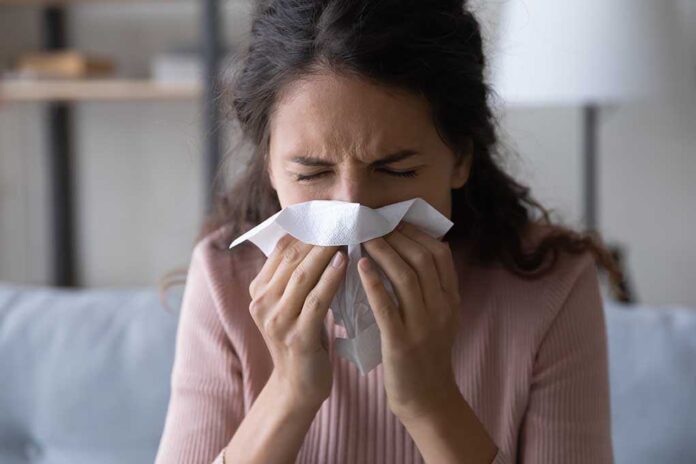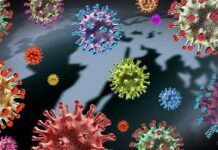
Wichita, Kansas takes the top spot as America’s worst city for allergy sufferers for the third consecutive year, according to a new report that reveals where symptoms will be most severe this spring.
At a Glance
- The Asthma and Allergy Foundation of America has released its 2025 “Allergy Capitals” report ranking the most challenging U.S. cities for allergy sufferers
- Wichita, Kansas, ranks first for the third consecutive year, followed by New Orleans and Virginia Beach
- Climate change is lengthening allergy seasons, with warmer temperatures increasing pollen production
- Eight California cities saw significant ranking jumps due to increased grass and weed pollen from wet weather
- Experts recommend strategies including antihistamines, nasal sprays, and limiting outdoor exposure during peak pollen times
Understanding the 2025 Allergy Capitals Rankings
The Asthma and Allergy Foundation of America (AAFA) has released its annual report identifying the 20 U.S. cities where allergy sufferers face the most challenging conditions. The rankings are based on a comprehensive analysis of pollen scores for trees, grasses, and weeds, over-the-counter medication usage, and the availability of board-certified allergists and immunologists in each area. This year’s list shows significant shifts, with certain regions facing particularly difficult conditions due to environmental factors and weather patterns.
“This year’s report named Wichita, Kansas, as the top 2025 Allergy Capital for the third year in a row due to its: – Worse-than-average tree and grass pollen – Worse-than-average allergy medicine use – Worse-than-average number of board-certified allergists/immunologists,” states the Asthma and Allergy Foundation of America.
New Orleans made a dramatic jump from 34th to 2nd place this year, primarily due to a severe weed pollen season exacerbated by Hurricane Francine and unusually warm temperatures. The southeastern United States claims a significant presence on the list, with Virginia Beach, Richmond, and Tulsa rounding out the top five. Meanwhile, California saw eight of its cities climb significantly in the rankings due to increased grass and weed pollen levels resulting from wet weather patterns in 2024.
The Growing Impact of Climate Change on Allergies
Climate change is having a profound effect on allergy seasons across the country, with warming temperatures extending pollen seasons and increasing pollen production. The winter break from allergies that many once enjoyed is becoming shorter, with some individuals now experiencing allergy symptoms almost year-round. This trend is particularly concerning for those with allergic asthma, a potentially life-threatening condition triggered by seasonal allergies.
“Unfortunately, every year pollen counts seem to be getting worse, and that’s largely related to global warming,” explains Dr. Payel Gupta, allergist and immunologist, in Everyday Health.
Kenneth Mendez, President and CEO of the AAFA, highlighted the severity of the issue: “There’s something called allergic asthma, which is asthma that’s triggered by seasonal allergies. What a lot of people don’t realize is that 10 people die each day from asthma, so it’s really important to have your allergies under control if you have allergic asthma,” as reported by Border Report.
Effective Strategies for Managing Spring Allergies
For the more than 100 million Americans suffering from allergies, understanding and managing triggers is essential. Pollen seasons typically occur in three waves: tree pollen from February to April, grass pollen from April to July, and weed pollen from August until the first frost. Experts recommend several strategies to minimize symptoms during these peak periods, including monitoring local pollen forecasts, using appropriate medications, and modifying daily routines.
“One of the most important things that we recommend is to use a 24-hour antihistamine, because they’re longer-acting and can really help control symptoms,” advises Dr. Purvi Parikh, allergist and immunologist with the Allergy & Asthma Network, in Fox News.
Other effective management techniques include using nasal corticosteroid sprays, which can reduce inflammation, changing clothes after being outdoors to remove pollen, and keeping windows closed during morning hours when pollen counts are typically highest. For those with severe symptoms, consulting with an allergist about immunotherapy options like allergy shots may provide longer-term relief. Indoor air quality improvements, such as using HEPA filters and controlling moisture to prevent mold growth, can also create healthier living spaces even in allergy-prone areas.
When to Seek Professional Help
While over-the-counter remedies work for many allergy sufferers, understanding your specific triggers is crucial for effective management. Allergies that significantly impact quality of life or trigger asthma symptoms warrant professional attention. A specialist can provide testing to identify specific allergens and develop a tailored treatment plan. This becomes especially important for residents of high-ranking allergy capitals where environmental conditions create persistent challenges.
“We tell people all the time, understand what your triggers are. The only way you could understand what your triggers are so you can manage your allergies is to see a specialist,” emphasizes Kenneth Mendez in Border Report.
With allergy seasons becoming longer and more severe due to climate change, even individuals who previously had no allergies may begin experiencing symptoms. The changing patterns of pollen distribution mean that preparation and awareness are increasingly important for maintaining respiratory health during spring and beyond. By taking proactive steps and staying informed about local pollen conditions, allergy sufferers can minimize symptoms and enjoy the season with greater comfort.
























